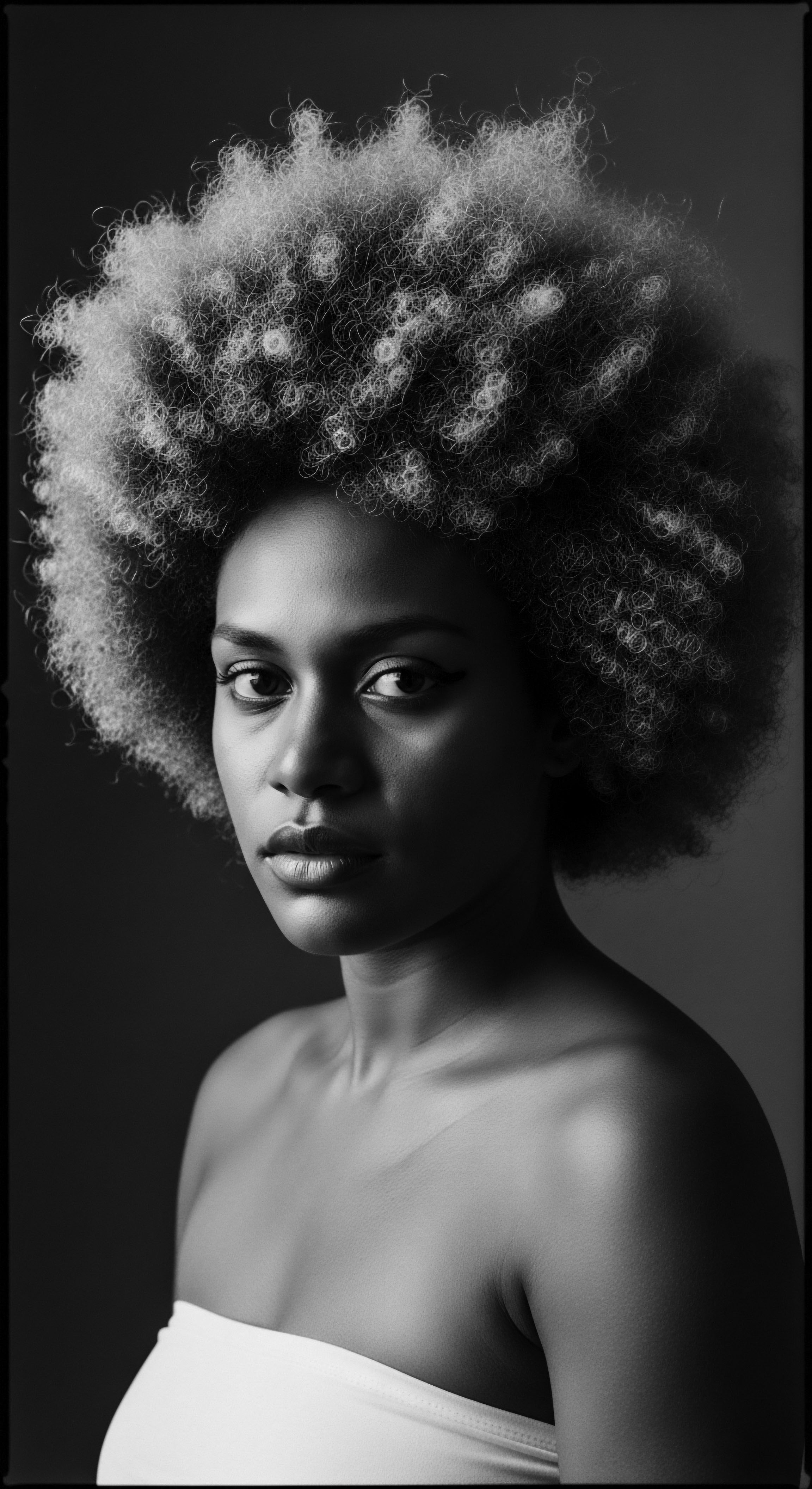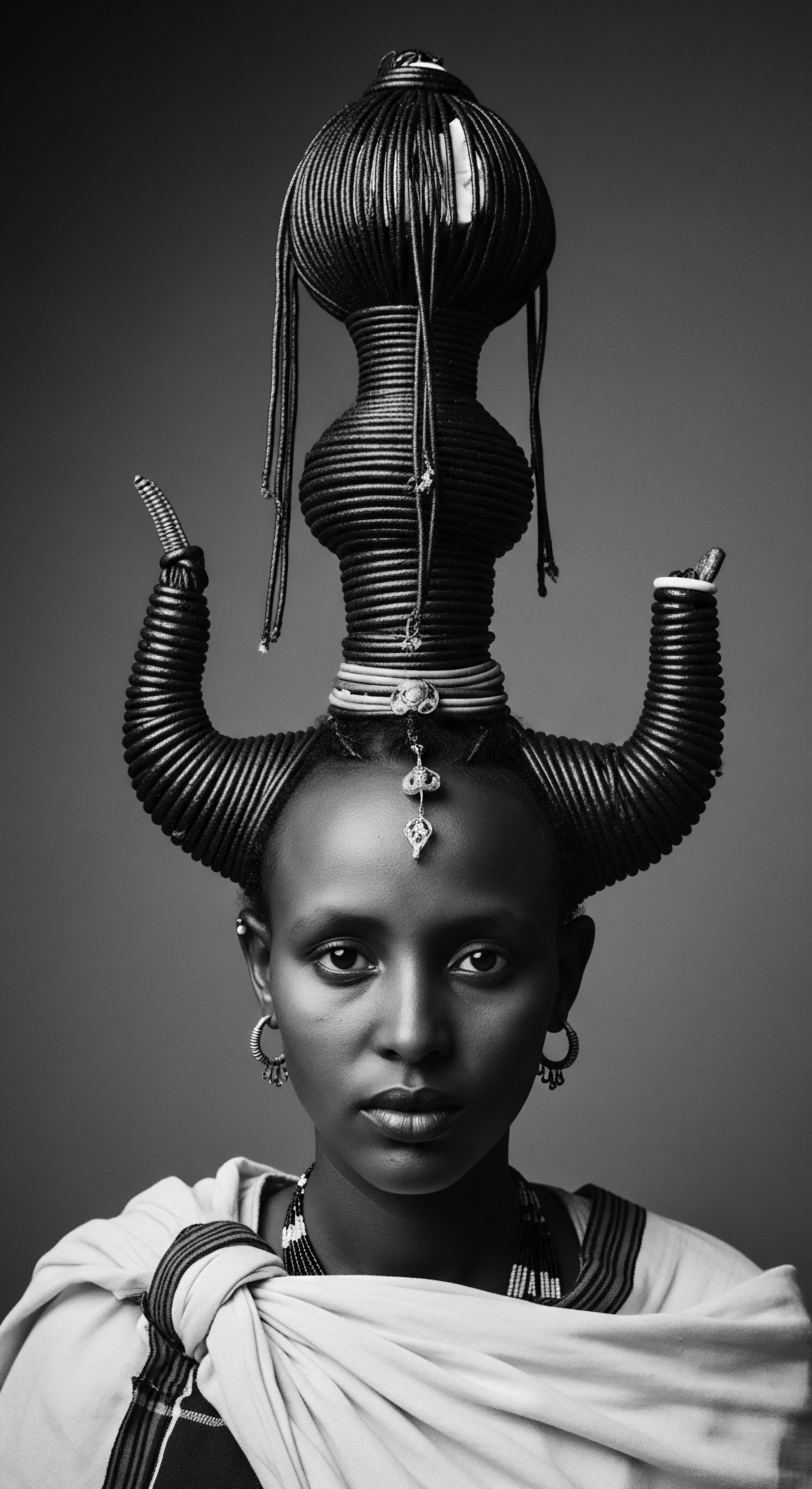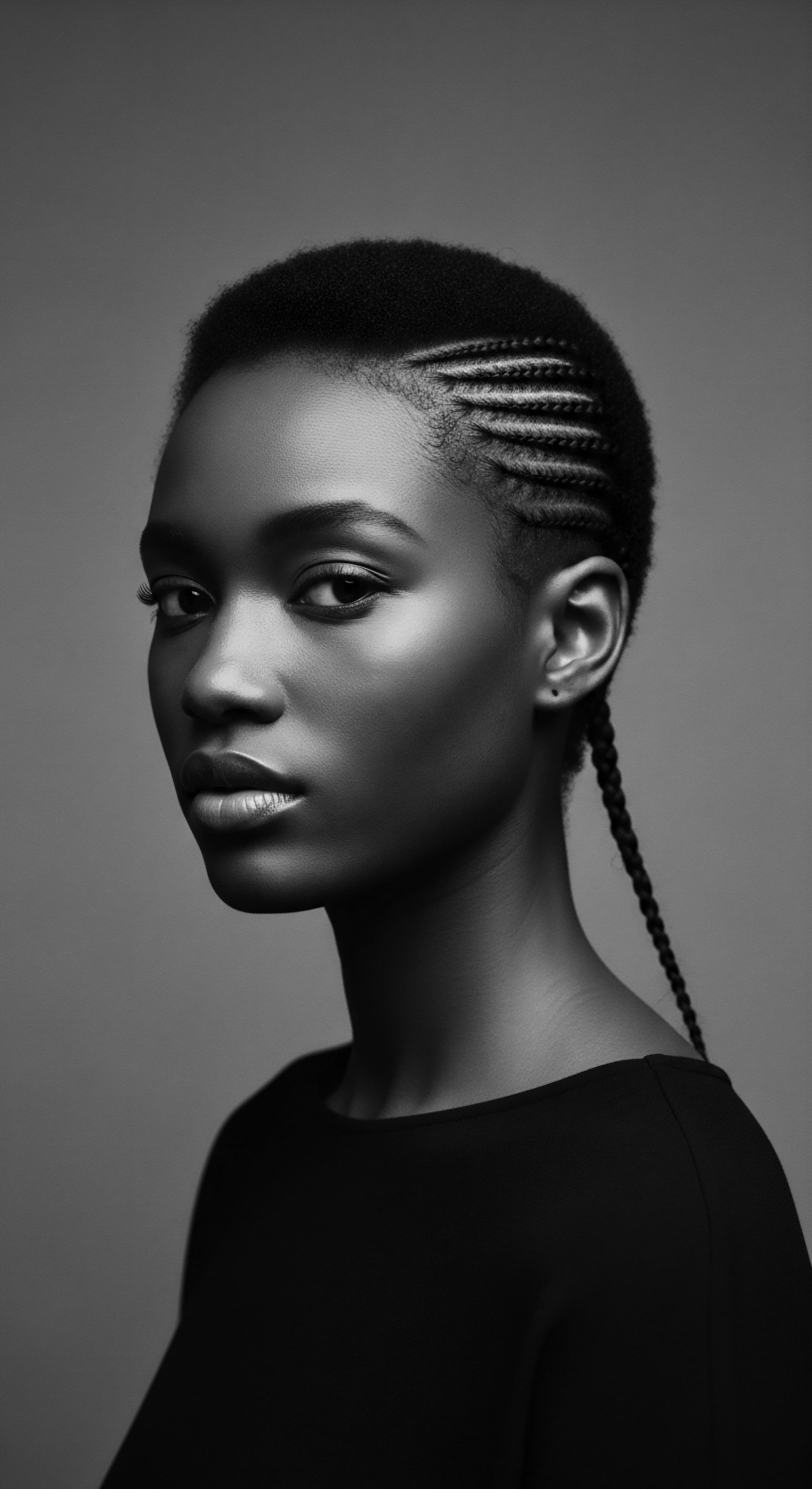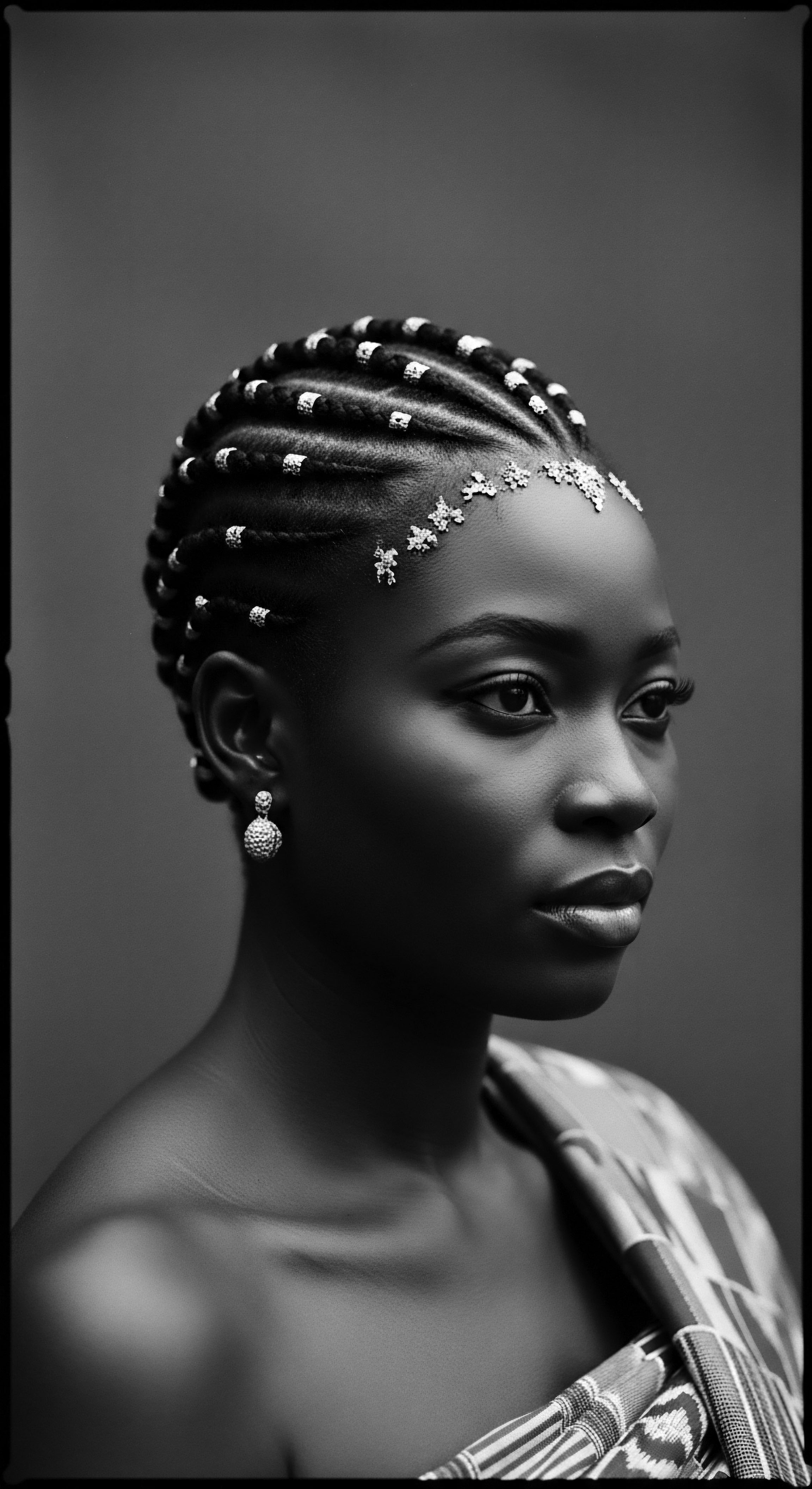
Roots
Consider the story held within each coil, each twist of textured hair. It is a chronicle of resilience, a living memory passed down through countless generations. This hair, often dismissed or misunderstood in dominant beauty narratives, holds an ancestral wisdom, its very structure a testament to enduring strength.
When we speak of fermented ingredients and their gifts to textured hair, we are not simply discussing chemistry; we are reaching back to ancient wells of knowledge, to practices born from necessity, ingenuity, and a profound connection to the earth’s bounty. The conversation around hair health, particularly for Black and mixed-race communities, is always, at its core, a conversation about heritage.
Fermented ingredients, substances transformed by beneficial microorganisms, have been silent partners in human wellness for millennia. Before laboratories and complex formulations, our ancestors practiced alchemy, using the invisible world of microbes to enhance what nature provided. They coaxed new life and potency from grains, fruits, and plants, discovering, through observation and inherited wisdom, their capacity to nourish the body, both within and without.
This ancestral understanding, honed over centuries, is now being validated by contemporary science, bringing the wisdom of the past into sharp focus for today’s textured hair care. The science of hair itself, from its microscopic anatomy to its growth cycles, finds new resonance when viewed through this historical lens, particularly when considering the unique needs of curls and coils.

What is Textured Hair’s Ancestral Architecture?
To truly understand how fermented ingredients contribute to textured hair’s wellbeing, one must first appreciate its inherent design. Textured hair, whether tightly coiled, loosely curled, or a zig-zag pattern, possesses a distinct anatomical blueprint. Unlike straight hair, which is round in cross-section, textured strands are typically oval or elliptical. This shape, combined with the way the hair shaft spirals as it grows, creates more points of contact with neighboring strands, leading to tangling and a greater propensity for dryness.
The cuticle, the outermost protective layer, often lifts more readily in highly textured hair, making it more vulnerable to moisture loss and damage from environmental stressors. These characteristics are not flaws; they are the natural variations of human hair, developed over millennia in diverse climates and conditions. Our ancestors, living closely with the land, understood these qualities intuitively. They sought ways to retain moisture, to strengthen the delicate strands, and to protect their crowns from the sun and elements, often turning to natural resources.
Beyond the physical, there is a lexicon of textured hair that carries cultural weight. Terms like ‘coily,’ ‘kinky,’ ‘afro,’ ‘locs,’ ‘braids,’ and ‘twists’ are not merely descriptors; they represent styles, cultural markers, and statements of identity that have persisted through history, often despite attempts at suppression. The practices surrounding these styles, from daily moisturizing to elaborate ceremonial preparations, were often rooted in the use of natural ingredients, some of which, we now know, underwent a form of fermentation in their preparation or application.
The story of textured hair is an echo of enduring strength, a testament to ancestral ingenuity.

Fermentation’s Footprint in Heritage Hair Practices
Fermentation, in its simplest form, is a process where microorganisms convert organic compounds into simpler substances. For textured hair, this biological transformation yields a treasure trove of benefits. Consider the ancient women of the Yao ethnic group in the village of Huangluo, China, renowned for their strikingly long, dark hair, which often retains its color well into their eighties. Their secret?
The ritualistic use of fermented rice water. This practice, passed through generations, demonstrates a powerful, living tradition where the benefits of fermentation are visibly manifested. A study examining the effects of fermented rice water noted an increase in hair growth rate and improved hair quality in test subjects, with proteins found in high concentrations in the mixture of rice varieties used.
While rice water often dominates the contemporary discussion, the reach of fermented ingredients in ancestral hair care spans far wider. Historical accounts and ethnographic studies hint at diverse applications:
- Fermented Milks ❉ Some communities in East Africa traditionally used butter made from fermented milk to keep hair soft and shiny, a practice that likely offered moisturizing fats and a mild acidity.
- Fermented Plant Juices ❉ In ancient Egypt, remedies for skin, including those applied to the head, sometimes incorporated fermented plant juice for various conditions, indicating an early understanding of their beneficial properties. (Ead, 2007)
- Traditional Brews ❉ Certain indigenous groups across various continents likely used fermented plant-based infusions or concoctions, not just for internal consumption, but also topically for their medicinal or conditioning properties on hair and scalp, even if not explicitly documented for “fermented hair care” in modern terms. These often involved simple maceration and natural microbial activity.
These historical precedents are not isolated curiosities. They represent a continuum of knowledge, a dialogue between humanity and the microbial world, where the very act of preparing ingredients for hair care became a slow, deliberate act of enhancement. The reduction of complex compounds into more bioavailable forms, the creation of beneficial acids, and the proliferation of helpful microorganisms—all these natural processes, once observed and replicated, supported the vitality of textured hair in ways our ancestors understood deeply, even without modern scientific terminology.
The very pH of hair and scalp plays a crucial role in maintaining health. Textured hair, with its often raised cuticle, benefits from a slightly acidic environment that helps smooth down the cuticle, reducing frizz and sealing in moisture. Fermented ingredients naturally possess a more acidic pH, making them inherently compatible with the physiological needs of textured hair. This intrinsic compatibility speaks to an ancient wisdom that aligns perfectly with contemporary scientific understanding.
| Ancestral Ingredient/Practice Fermented Rice Water |
| Historical Application & Cultural Context Yao women of China; a multi-generational ritual for hair strength and length, believed to prevent early graying. |
| Modern Scientific Link to Hair Health Contains inositol (repairs damaged hair), amino acids (strengthens), vitamins B, C, E, and antioxidants; pH balancing. |
| Ancestral Ingredient/Practice Fermented Milks/Butters |
| Historical Application & Cultural Context East African traditions for softening and conditioning hair, providing rich emollients. |
| Modern Scientific Link to Hair Health Source of lactic acid (mild exfoliant, pH balancer), fatty acids (moisturizing), and potentially probiotics for scalp biome. |
| Ancestral Ingredient/Practice Fermented Plant Juices/Oils |
| Historical Application & Cultural Context Ancient Egyptian remedies for various skin conditions, potentially scalp-related. |
| Modern Scientific Link to Hair Health Enhanced bioavailability of nutrients, increased antioxidant levels, enzymes, and organic acids for scalp circulation and sebum control. |
| Ancestral Ingredient/Practice These examples reflect a deep, intuitive understanding of natural processes, aligning ancestral wisdom with the intricate science of hair wellness. |

Ritual
The acts of styling and maintaining textured hair extend beyond mere aesthetics; they are often sacred rituals, passed hands to hands, from elder to youth, holding stories of identity, resistance, and continuity. These practices, honed over centuries, represent a dialogue with heritage, a living library of communal knowledge. The incorporation of ingredients that have undergone fermentation finds its place within this rich tradition, influencing how hair is prepared, protected, and presented, transforming functional care into a deep, tender ritual. Fermented ingredients do not just alter the hair’s structure; they become part of a profound cultural dialogue.
Consider the meticulous detangling sessions, the braiding patterns that served as maps or symbols, the coiling and twisting that created protective shields. Each movement, each application of balm or rinse, was a step in preserving the hair’s inherent beauty and vitality. Modern science now sheds light on how fermented ingredients, particularly their chemical and biological outputs, align with these age-old goals.
They enhance moisture, improve elasticity, and strengthen the very architecture of the hair strand, supporting the longevity of protective styles and the health of naturally defined textures. This scientific understanding simply adds a new layer to an already deep, ancestral narrative of care.

How Fermentation Bolsters Hair’s Resistance?
Textured hair, with its unique bends and curves, can be more prone to breakage and dryness. The cuticle, the outer protective layer of the hair shaft, tends to lift more easily, exposing the cortex and leading to moisture loss. This characteristic makes products that can help smooth the cuticle and seal in hydration particularly valuable.
Fermented ingredients, often rich in organic acids, contribute to a slightly acidic pH, which helps to flatten the cuticle, thereby increasing shine and reducing frizz. This action mimics the natural acidic mantle of a healthy scalp, creating an optimal environment for hair.
Beyond pH balance, the fermentation process itself breaks down larger molecules into smaller, more bioavailable components. This means that proteins, vitamins, and antioxidants present in the original ingredients become more easily absorbed by the hair and scalp. For instance, fermented rice water provides a concentrated source of amino acids and inositol, a carbohydrate shown to remain in the hair fiber even after rinsing, offering internal repair and strengthening. This is not a superficial coating; it is a deep, internal fortification of the strand, contributing to the hair’s overall strength and resilience.
Fermented ingredients are a bridge between ancient wisdom and contemporary hair needs, enhancing natural textures.

Preserving Coils through Traditional Care Techniques
Many traditional textured hair care techniques prioritize protection and moisture retention. Think of the elaborate braiding patterns that keep ends tucked away, or the oiling rituals that seal in hydration. Fermented ingredients seamlessly integrate into these practices. For instance, a traditional practice often involves applying a conditioning rinse before styling.
A fermented rice water rinse, for example, could be used as a pre-shampoo treatment or a final rinse to improve hair elasticity and reduce surface friction, making detangling easier for curly hair. This ease of detangling is not merely a convenience; it is a critical step in minimizing breakage for textured hair, which is inherently more fragile due to its curl pattern.
The use of fermented oils also finds a place here. Fermentation can reduce the molecular size of oils, allowing them to penetrate the hair shaft more deeply, delivering fatty acids and antioxidants directly to the follicles. This deep nourishment supports the hair’s structure from within, making it stronger and less susceptible to damage from styling or environmental stressors.
Historically, oils have been central to hair care rituals across African and diasporic communities, providing moisture and protection. The enhancement of these oils through fermentation represents a subtle but powerful evolution of these traditions, amplifying their innate goodness.
Consider specific styling needs:
- Protective Styles ❉ For braids, twists, and locs, the goal is often to minimize manipulation and maintain moisture. Fermented ingredients, by improving elasticity and strengthening strands, help these styles last longer and cause less stress on the hair when eventually taken down.
- Natural Definition ❉ When aiming for defined curls or coils, products that reduce frizz and enhance shine are key. The pH-balancing properties of fermented ingredients contribute to cuticle smoothing, leading to more defined, lustrous results.
- Scalp Health ❉ A healthy scalp is the foundation for healthy hair, particularly for textured hair, where styling often puts tension on the scalp. Fermented extracts, rich in probiotics and postbiotics, can help balance the scalp microbiome, reducing issues like dandruff and irritation. This creates a calm, healthy environment where hair can thrive.
The interplay between ancestral practice and the science of fermentation reveals a profound circularity. The wisdom of our forebears, often empirical and passed through generations, intuited benefits that modern scientific inquiry now meticulously details. In doing so, fermented ingredients stand as a living testament to the ongoing conversation between past and present, enriching our rituals of hair care and deepening our connection to heritage.

Relay
The ongoing care and maintenance of textured hair is not a fleeting trend; it is a continuous relay of knowledge, a torch passed from one generation to the next, adapting and evolving while retaining its core wisdom. This heritage, particularly within Black and mixed-race communities, has always recognized hair as a vibrant extension of self, deserving of meticulous, holistic attention. Fermented ingredients, with their deep scientific backing and historical resonance, serve as a potent conduit for this relay, blending ancient practices with modern understanding to support truly radiant, thriving hair. The nuances of molecular biology and microbial action become, in this context, whispers from the past, confirming and amplifying the efficacy of time-honored remedies.
This enduring legacy calls for a comprehensive approach to hair wellness, one that looks beyond superficial fixes to the intricate ecosystem of the scalp and the structural integrity of each strand. Ancestral wellness philosophies often understood that external applications were part of a larger, interconnected system of well-being. Today, we understand that connection through the lens of the microbiome and nutrient absorption, discovering how fermented elements can optimize these biological processes, leading to hair that not only looks healthy but is genuinely resilient from within. The integration of traditional knowledge with contemporary research offers a profound affirmation of our heritage.

Do Fermented Ingredients Truly Rejuvenate the Scalp’s Ecosystem?
The scalp is a vibrant ecosystem, home to a diverse community of microorganisms known as the scalp microbiome. A balanced microbiome is essential for hair health, influencing everything from follicle activity to oil balance and sensitivity. When this balance is disrupted by external factors or internal imbalances, issues like dryness, itchiness, dandruff, or even excessive shedding can arise. This is where fermented ingredients offer a compelling solution.
Fermented extracts and oils often contain a wealth of beneficial compounds, including probiotics (live microorganisms), postbiotics (metabolic byproducts of fermentation), and prebiotics (compounds that feed beneficial microbes). These elements work in harmony to support a healthy scalp environment. For instance, Lactobacillus Ferment, a common probiotic derivative, can help balance the scalp’s microbial community, promoting an environment where beneficial bacteria can thrive while inhibiting the growth of harmful pathogens. This modulation contributes to a stronger scalp barrier and can alleviate symptoms of irritation and inflammation.
A balanced scalp pH is another critical factor, particularly for textured hair. The natural pH of the scalp ranges from 4.5 to 5.5, which is slightly acidic. Many conventional hair products can disrupt this delicate balance. Fermented ingredients, by their very nature, tend to be mildly acidic, aligning with the scalp’s optimal pH and helping to smooth the hair cuticle.
This acidifying action helps to seal in moisture and reduce the likelihood of issues like frizz and dryness. This natural affinity between fermented ingredients and the hair’s physiological needs speaks volumes about the wisdom of ancestral practices.
Fermentation breathes new life into hair care, offering resilience rooted in our natural world.

Can Fermented Actives Enhance Nutrient Absorption for Textured Hair?
One of the most significant advantages of fermented ingredients lies in their enhanced bioavailability. During fermentation, complex molecules are broken down into smaller, more easily absorbed forms. This means that the vitamins, minerals, amino acids, and antioxidants present in raw ingredients become more potent and readily available for the hair and scalp to utilize. For textured hair, which often requires a higher level of nourishment and moisture retention, this improved absorption can be transformative.
Consider the building blocks of hair itself ❉ proteins. Hair is primarily composed of keratin, a protein. Fermented ingredients can provide amino acids, the constituents of protein, in a highly usable form, helping to strengthen the hair shaft and reduce breakage. Research indicates that fermented rice water, for example, is rich in amino acids that repair damaged hair and enhance elasticity.
Beyond direct application, the connection between gut health and hair wellness also highlights the systemic impact of fermented foods. Short-chain fatty acids (SCFAs), which are produced by gut microbes during the fermentation of dietary fiber, play a regulatory role in immune responses and nutrient absorption, which can indirectly affect hair growth and scalp conditions. (Garg & Singh, 2019) This underlines a holistic approach to textured hair care, one that recognizes the intricate connections between internal health and external radiance.
Nighttime rituals, a cornerstone of textured hair care, gain new depth with the inclusion of fermented elements. The consistent protection offered by bonnets and wraps, combined with nutrient-rich applications, creates an ideal environment for rejuvenation. Applying a leave-in treatment or oil infused with fermented ingredients before sleep allows ample time for these bio-actives to work, deeply nourishing the scalp and strands as the body rests. This quiet, restorative practice honors the generational commitment to preserving hair health.
- Fermented Rice Water ❉ Known for strengthening hair, reducing surface friction, and providing shine due to inositol and amino acids.
- Fermented Ginseng ❉ Some studies suggest fermented red ginseng can promote hair growth by enhancing hair follicle activity and increasing anagen-phase hair follicles. (Kim, et al. 2023)
- Fermented Coconut Milk/Oil ❉ Offers enhanced moisturizing properties and beneficial fatty acids for hair hydration and protection.
- Lactobacillus Ferment Filtrate ❉ A common postbiotic that balances the scalp microbiome, reduces irritation, and conditions hair.
The synthesis of ancestral wisdom and modern scientific inquiry offers a powerful path forward for textured hair care. It is a path that honors the past, empowers the present, and builds a legacy of vibrant hair health for generations yet to come, all through the remarkable, unassuming power of fermentation.

Reflection
To observe textured hair is to witness a living archive, a scroll of time and tradition. Each curl, each strand, holds the echoes of countless hands that have tended, braided, and crowned, hands that understood the deep language of natural elements long before scientific terms became common parlance. The story of fermented ingredients in supporting textured hair health is a testament to this enduring lineage, a powerful reminder that the wisdom of our forebears often held keys to wellness that we are only now beginning to fully comprehend.
Roothea’s ethos, the ‘Soul of a Strand,’ finds its truest expression in this convergence. It is a recognition that hair care extends beyond superficial beauty; it is a profound act of self-connection, a ritual of honoring the past, and a declaration of present identity. The ancient practices of coaxing life from grains, milks, and plant matter through fermentation were not merely utilitarian. They were acts of mindful engagement with the cycles of nature, a deep understanding of transformation, and an intuitive alignment with biological processes that nurture.
As we navigate modern landscapes, the call to reconnect with this heritage grows stronger. The scientific validation of fermented ingredients – their ability to enhance nutrient absorption, balance the scalp’s delicate ecosystem, and strengthen the hair’s very structure – bridges the temporal gap. It offers a profound affirmation ❉ the paths paved by our ancestors were not just trails, but enduring highways to holistic well-being.
Textured hair, in all its varied forms, continues to be a vibrant canvas for this ancestral wisdom, a living legacy that invites us to listen, learn, and grow. The journey of textured hair health, powered by fermentation, remains a continuous, sacred unfolding.

References
- Khadge, S. & Shinde, S. (2023). EFFECT OF FERMENTED RICE WATER ON HAIR. Journal of Emerging Technologies and Innovative Research, 10(6).
- Ead, H. A. (2007). Cosmetics in Ancient Egypt. Alchemy Website.
- Garg, P. K. & Singh, A. (2019). Exploring the Connection Between Gut Health and Hair. Practical Dermatology.
- Kim, D. C. Kim, E. Y. Kim, Y. Kim, J. Y. Jung, J. Lim, S. Y. Lee, Y. Y. Kim, Y. S. Shin, K. H. & Kim, C. H. (2023). Promotion of hair growth by Lactobacillus and fermented traditional Korean berry in C57BL/6 mice. American Journal of Physiology-Endocrinology and Metabolism, 325(1).
- Marto, J. Gouveia, M. & Trindade, J. (2018). Rice Water ❉ A Traditional Ingredient with Anti-Aging Efficacy. Cosmetics, 5(4), 58.
- Paiewonsky, B. et al. (2022). Hairfluencer social media trends every dermatologist should know in 2021. Journal of the American Academy of Dermatology, 86(3), 676-679.
- Squire, R. & Goode, K. (2022). A randomised, single-blind, single-centre clinical trial to evaluate comparative clinical efficacy of shampoos containing ciclopirox olamine (1.5%) and salicylic acid (3%), or ketoconazole (2%). Journal of Cosmetic Dermatology, 21(8), 3423-3430.
